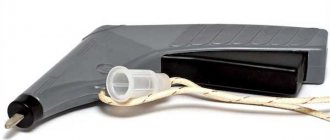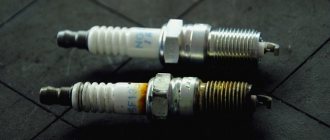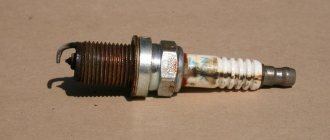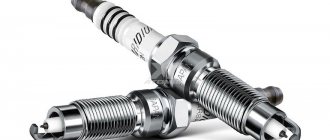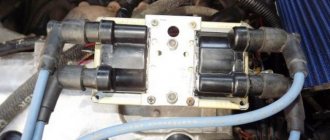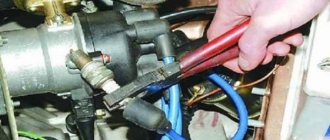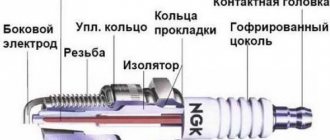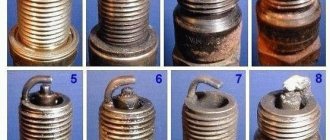Do you know how often you need to change spark plugs and what time of year is best to do it? What actually determines the frequency of change: running time or riding intensity? At what mileage or at what time after installation is it best to replace the spark plugs with new ones? What causes them to usually fail? How to visually determine the need to replace them? And why do mechanics ALWAYS insist on replacing spark plugs?
Read about all this in our article. And first of all, we will tell you why you need to change the spark plugs, because the old car drives well.
Why change working spark plugs?
Why replace spark plugs with new ones if the old ones are working? This question has always been relevant. Because the desire to save on unnecessary things at least partially clung to the mysterious Russian soul.
Previously, musicians spent all weekends in garages, tightening up something, repairing something, adjusting something. In order to change spark plugs less often, they were systematically unscrewed, dried at home on the stove, cleaned and bent the electrodes. Now there is a different generation of people and cars, and few people are willing to spend their personal time on car repairs and maintenance.
Nevertheless, the stability of the engine largely depends on the condition of the spark plugs. Just because they are still in working order does not mean they are fully serviceable. While you think everything is fine, the engine may be irreversible. Below we will tell you what and why.
Signs of spark plug wear
Signs of wear are sometimes very noticeable, since this device takes part in the direct operation of the engine and ignition of the combustible mixture. Therefore, it is immediately clear when to change the spark plugs. If the car twitches while driving, the starter does not work immediately, and in order to start the car, several idle revolutions are required; if fuel consumption increases and engine dynamics decrease, the time comes when you need to change the spark plugs.
Determining the malfunction and the period after which to change the spark plugs is carried out in several ways. If the car does not start, or does not start immediately, it is worth determining what could be causing this. The malfunction leads to a decrease in engine performance, if when the engine is turned on, an interval or gap appears in the cycle of uniform spark supply - not only its performance is reduced. The volume of evaporation during fuel combustion increases, raw fuel enters the gas exhaust system, which causes overheating and overload in the operation of the catalytic catalyst. It goes without saying that this cannot but affect the condition of the entire system, and then it is necessary to change the spark plugs if it is determined that they are the cause of gaps or pauses.
If there is a gap in the engine operation, the exhaust of unburnt fuel can also cause the catalyst to fail and the engine to stall. The catalyst is not cheap, and only replacing it can correct the situation.
Why change spark plugs for no apparent reason - they directly affect fuel consumption. If carbon deposits form, more fuel mixture will be used with less efficiency. There may also be problems with starting the engine, especially when it is cold outside or after a long period of inactivity, for example in the morning.
What does a spark plug consist of and what functions does it perform?
Well, a little theory! If anyone doesn't already know, the spark plug is necessary to ignite the fuel-air mixture in the engine cylinder. How many cylinders, how many spark plugs? The spark plug consists of 6 main parts. Each of them has its own function.
| Element | Function |
| 1. contact pin | Connects the spark plug to the vehicle's electrical system. |
| 2nd central electrode 3) side electrode | create a potential difference to form a spark |
| 4. insulator | Prevents the fork from overheating |
| 5. Insulator ribs | Preventing failure on the outer surface of the insulator |
| 6th mark | prevents the penetration of hot gases |
Proper operation of spark plugs ensures efficient combustion of fuel in the engine, saves fuel and prevents premature engine wear.
Meanwhile, the spark plug itself must withstand extreme conditions and phenomena, such as:
- heat
- high pressure
- Voltage
- spark effects
In addition, spark plugs often develop deposits due to poor quality fuel. Or due to the presence of various additives in fuel and oil.
Sooner or later, each of these factors will lead to spark plug failure. Sometimes this happens gradually (for example, soot accumulation), sometimes it happens all at once (breakage).
Spark plug design
A classic spark plug is a complex structure based on two or more electrodes, a contact element (head), an insulator, a base, sealing and spacer rings.
- Central electrode
is the important and hottest segment of the spark plug arrangement. It is most often connected through a ceramic resistor to the head to reduce interference. The tip (head) is made of iron-nickel material, with an admixture of chromium, copper, as well as rare earth and/or noble alloys.
Side electrode
made of steel alloyed with manganese or nickel. It is welded to the base using resistance welding. Depending on the design solution, there may be several side contacts. At the very end of the last century, plasma-focal type candles began to be produced. For them, the role of the side electrode is assigned to the base. This arrangement provides an annular spark discharge.
Contact head
provides connection of high-voltage wires or ignition coil.
Base or housing
provides fixation of the spark plug in the cylinder block, removes heat and acts as a “ground” conductor to the side electrode (electrodes).
Insulator
Modern candles are made of ceramic with the addition of aluminum oxide and are designed to prevent the candle from overheating. The insulator ribs prevent voltage breakdown on its surface. The insulator material is designed for temperatures up to +1000 °C and voltage
Rings
(seals) serve to prevent the release of hot gases from the compressor.
What happens if you don't change the spark plugs on time?
If at least one of the plugs does not work properly, the car immediately fails. Also, just because of the spark plug, you can end up in quite an expensive repair.
So, possible problems and their consequences:
- A change in the gap between the electrodes of the spark plug (electrode melting, burnout, soot deposition) leads to a weakening of the spark, misfire, etc. Trojan engine. Poaching occurs when one of the cylinders is faulty or not working at all, the engine itself vibrates strangely, misfires occur, and the exhaust system makes a knocking noise.
- A weak spark reduces the completeness of combustion of the fuel mixture.
- The formation of soot or debris on the electrodes can cause coil failure and damage to associated ignition system components.
- Misfire increases cylinder knock, accelerates corrosion of cylinder walls and pistons, and causes deposits to form in the working fluid. At sub-zero temperatures, starting the engine may be difficult.
In some cases, reluctance to replace the spark plug can lead to a major overhaul of the entire cylinder block. Cylinder detonation may occur on the crankshaft. The integrity of connecting rods and pistons is excluded.
It should be remembered that long-term use of spark plugs without preventive unscrewing creates ideal conditions for plugging the threaded connection. This is either a repair or a complete replacement of the unit.
How often to change spark plugs
How often spark plugs need to be changed on a particular vehicle is usually documented. For your convenience, the manufacturer indicates which brands of spark plugs it recommends to use and how often they should be changed: after what time or mileage.
In fact, a lot depends on the type of plugins themselves. For example, platinum is exchanged for 50-60 thousand. km, and iridium 100 thousand km. However, they are more expensive and are rarely used. Usually cars are equipped with classics, which need to be changed after 10-20 thousand. km mileage By the way, under favorable conditions and periodic cleaning, it can have the same 50 thousand. mileage.
And even if you have 50 thousand in your papers. km, and in a year you have driven no more than 15 thousand. km, at your next inspection you will be asked if you want to replace the spark plugs. And it is right.
Experienced drivers and service technicians agree that spark plugs should be replaced once a year. Moreover, this should be done in the fall in preparation for the winter period.
Why in autumn?
When the weather worsens (ice and snow), the operating conditions of the vehicle deteriorate sharply. Also, negative temperatures play an important role. All systems, including the ignition, work under increased load in winter and will fail if there are any problems. Thus, by winter the car should achieve maximum performance.
Therefore, before the start of winter, it is necessary to check, at least clean, and preferably replace the spark plugs with new ones. And not just one or two plugs, but a complete set at once.
Spark plugs are the same consumable item; it is stupid to skimp on replacing them. After all, once a year is not so often.
What type of spark plugs can be changed to another?
If desired, you can change the type of candle in the direction of choosing an improvement, that is, candles that were developed and released later than the release of this car model. For example, replacing “simple” ones with platinum ones, in which the electrode is made of iridium, or spark plugs in which there are a larger number of electrodes.
When choosing spark plugs that can be installed on a car, you need to understand that the manufacturer installs a type of spark plug on the car that is produced, which can be self-sufficient, that is, neither good nor bad. So, as it is not profitable to put expensive ones, but at a lower quality, you lose value in the quality of the product. Therefore, the choice of candles for your “iron” pet falls entirely on the “shoulders” or wallet of the owner.
How do you know when it's time to change the spark plugs?
The frequency of replacing spark plugs depends not only on the mileage of the vehicle, but also on the condition of the spark plugs. There are many signs indicating possible faulty spark plugs:
- Strong smell of gasoline from the catalytic converter (indicates that the fuel is not burning completely).
- Increased fuel consumption (due to misfire).
- Difficulty starting the car engine.
- Unstable engine operation (spinning, stalling, low speed, reduced power, jerking) Sometimes detonation and other external sounds are clearly audible.
- Change in the nature of the exhaust gases (soot appears, an odor appears, the analyzer shows an increased CO level).
- Visual defects of spark plugs (cracks, nicks, melting, uneven color of electrodes, carbon deposits).
- The CHECK ENGINE warning light on the instrument panel comes on.
If your vehicle exhibits any of the above symptoms, it is recommended that you have your spark plugs checked.
If it's just a blockage, it can be cleaned and the spark plugs can be extinguished a little. If your spark plug has oil on it or has a strange residue on it, it might make sense to change the oil grade and start filling in a different location. If the spark plug shows visible signs of damage, replace it immediately!
Essence of the operation
The same applies to the operation of replacing spark plugs in a car, we will first consider it on a relatively popular Japanese car with a complex organization of the engine compartment.
So, we will describe in the following lines how parts are changed for a Subaru Forester car. For this procedure you will need to prepare the following:
- spark plug wrench with ratchet drive and extension;
- compressor.
- We dismantle the air filter housing and the windshield washer reservoir.
- On the first cylinder, pull out the high-voltage wire, holding the tip.
- We blow out the spark plug well with air from the compressor.
- Insert the spark plug wrench and unscrew the old part.
- We evaluate the condition of the old part, the degree of soot, ash deposits or oil traces (we'll talk about this later) by pressing the new part onto the threads in the socket with your hand, screw it in with a wrench, then insert the wire until it stops.
- Repeat the last three steps for the remaining three cylinders.
- Reinstall the air filter housing and windshield washer reservoir.
In other cars, replacing spark plugs is done in a similar way, the main thing is to first remove anything that prevents you from getting to the wells, and also blow out dust from the wells.
Let's see, for example, how a replacement is made for a Ford Focus 2. We will need:
- regular spark plug wrench without ratchet drive;
- 8 head with ratchet.
Also read about repairing the VAZ 2110 generator with your own hands and replacing the rear shock absorbers of the VAZ 2107.
What are we doing.
- First, remove the decorative plastic lining of the engine. We begin work with the first cylinder.
- Using a 8-mm socket, we unscrew the bolt securing the so-called spark plug “cradle,” through which voltage is transmitted from the high-voltage wire to our part being replaced.
- Having unclipped the plastic latch, we remove the high-voltage wire from the connector.
- Using a spark plug wrench, we unscrew the old part and assess its condition.
- We install a new part.
- We repeat the operation for the remaining cylinders.
This is interesting: How long do spark plugs last?
As you can see, in this machine, changing spark plugs looks like a slightly more complicated operation than in the previous case. An ignorant person may not even dare to open the engine casing.
Operation price
It is easier for such car owners to contact a car service center. For them, we will immediately indicate approximate prices for replacing spark plugs in a medium-complex car in three major cities of the Russian Federation. We present the data in the following table.
It is possible that such a price for work will frighten someone. Moreover, the operation under study does not cause difficulties on all machines.
Let's say everything looks simpler on German engines.
A couple more examples
For example, let’s look at how replacement occurs in a Volkswagen Polo Sedan. We will need:
- regular spark plug wrench;
- flat screwdriver.
- We unclip the decorative engine cover.
- We discovered 4 ignition coils. The wires are attached to them in latches on the sides. Using a screwdriver, unclip these high-voltage wires from the fasteners.
- We pull up the ignition coil on the first cylinder. We unscrew our treasured part with a spark plug wrench and assess its condition.
- Screw in the new part.
- We repeat the operation for the remaining cylinders.
It turns out that replacing the spark plugs on the Polo Sedan is not at all difficult.
The situation is much more complicated with the Nissan Qashqai, where replacement is fraught with significant difficulties. The fact is that on this machine our parts are “hidden” under the manifold.
To carry out the work we will need the following tools:
- spark plug key;
- screwdrivers;
- set of wrenches.
We begin to remove all interference.
- We dismantle the pipe between the throttle valve and the filter by disconnecting the ventilation system hose and also loosening the two clamps.
- Carefully disconnect the vacuum hose.
- Remove the connector of the absorber purge valve.
- We unscrew the bolt of the bracket (with a key on
 the block head.
the block head. - Having freed the hoses from the fasteners, unscrew the bracket under the throttle.
- A bolt has opened up, we unscrew it.
- Unscrew the 5 manifold bolts.
- Raise the manifold and throttle valve, after removing the oil dipstick. We secure the raised collector with wire.
- We take great care of cleanliness! Remove the connectors from the coils. We unscrew the coils and place each one near its cylinder.
- We change the parts one by one, according to the process already described earlier.
This is the kind of difficult work that needs to be done on a Nissan Qashqai in order to get to the treasured parts and install a new kit in their place.
Let us add that in all cases, on all machines, before installing new parts, it is advisable to lubricate the threads with a special thread lubricant that protects against seizing and sticking of the counter turns during operation.
Also, do not forget to blow out the wells if possible before unscrewing old parts.
When to change
I would like to say a few more words about assessing the condition of the removed kit and the frequency of replacing spark plugs on the car.
- When the insulator skirt is coffee-colored and the deposits on the electrodes are minimal, we can conclude that the engine is operating normally, even economically, as they say, like new.
- If there is dry soot on the electrodes, the engine is running with a mixture that is too rich in fuel. There may be problems with the injector.
- When the color of the electrodes is light gray, this means that the air-fuel mixture is lean. Possible reasons: incorrect ignition timing, low octane number of gasoline.
- The skirt has a reddish brick tint. Most likely, the fuel used contains a huge number of metal additives.
- If traces of oil are found on the electrodes, wear of the valve guides or piston rings cannot be ruled out.
As for the measured period for replacing spark plugs, it is usually determined by the mileage in the car’s passport - we have already mentioned this. The average value is 15 thousand km. However, each manufacturer of a certain brand of passenger car has its own regulations for replacing spark plugs.
In general, it is better to use a segment equal to 10 thousand km. – it will be perfect. It is better not to throw away old parts. Just in case, we'll leave them in the glove compartment. In the summer, when the new set suddenly breaks down, say, due to a defect, they will still work. Such cases have occurred among some car owners.
So, we have studied all the nuances associated with reinstalling the ignition kit in different cars. Our recommendations should help those who did not know the information contained in them. Now read about replacing the front springs of the VAZ 2106 and replacing the rear wheel bearing.
Author of the material: Mikhail Dumchenkov
Did you like the material? Share with your friends:
Have questions about car repairs? Ask them in the consultation section, to do this, click on the link below.
auto mechanic
The best prices and conditions for the purchase of new cars
Cars are presented by the leading showroom of RUSSIA
Guess which spark plug is faulty
It's not uncommon for an engine to feel like it's stumbling or just running, but all of the spark plugs appear fine and even free of carbon deposits. What to do in such a situation if we do not want to change the entire set at once?
Just disconnect each plug in turn from the wiring and observe the behavior of the motor, take it into account. The source of the problems is the spark plug, which does not change the engine's performance.
True, the cause of engine malfunction is not always the spark plug. Instead, after the replacement, you will realize that the problem is definitely not traffic jams.
What are modern candles made of?
Many modern manufacturers of these important engine parts are constantly modifying their products, producing spark plug electrodes from new materials. Therefore, some products may have a high cost, while other models are made as budget parts. But the principle of operation of these engine parts remains the same. A high voltage current flows through them, creating a powerful spark that ignites the fuel mixture, burning in the combustion chamber.
The main element of the spark plug is electrodes made of metal. A powerful spark jumps between them. In many cases, the service life of spark plugs depends on the quality of the electrode material. This determines the frequency of replacing spark plugs.
To find out after what time the spark plugs need to be changed, you must not only carefully study the manual, but also listen to the engine while driving.
Factors that reduce spark plug life
Therefore, factories provide us with complete information about how often the spark plugs on a car need to be changed. BUT! In recommendations for its replacement, manufacturers focus on the normal operating conditions of the car and the spark plugs themselves. However, there are a number of factors that significantly accelerate the wear of spark plugs and, as a result, their failure. These:
- Poor quality fuel or oil.
- Incorrect gasoline-air ratio (the cause may be a drop in compression, damage to the flow meter or lambda probe).
- Injector malfunction.
- Penetration of oil into the working volume.
- Misfire.
- The ignition angle is set incorrectly.
- Old car. Older cars have engines that are less stable than modern models.
- Gas fuel. The combustion temperature of gas is a third higher, so spark plugs in gas cars should be replaced almost twice as often.
- Using unsuitable spark plugs.
Timing for replacing spark plugs
You also need to take into account that you need to change spark plugs, taking into account their type and material of manufacture:
- conventional spark plugs with a copper electrode must be replaced after 20-30 thousand km,
- devices with platinum and iridium electrodes are replaced after approximately 90 thousand km.
There are also spark plugs on the market with copper electrodes coated with yttrium alloy, which somewhat extends their service life compared to classic ones. But still, the most “long-lasting” are devices with electrodes made of an alloy of iridium and platinum.
It must be taken into account that in many respects the interval for replacing spark plugs is determined by the operating conditions of the vehicle, mainly by the quality of the fuel used. Therefore, if you constantly refuel at proven network gas stations, then the spark plugs on your car with a high degree of probability will be able to “expend” their allotted life. Nevertheless, approximately every 10 thousand kilometers it is better to visually check the absence of carbon deposits on the electrodes, chips of ceramics, etc.


